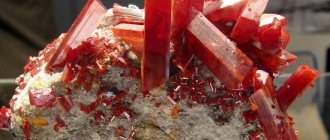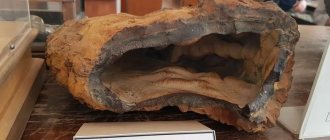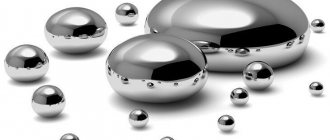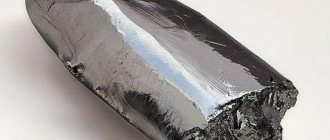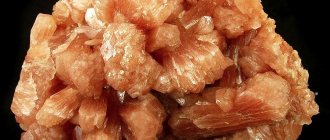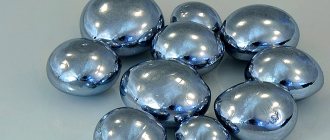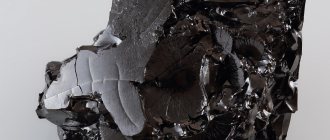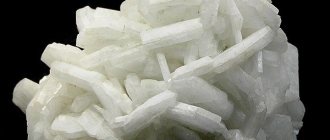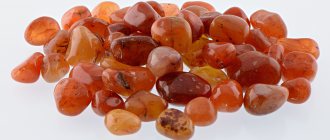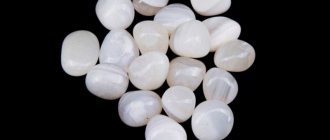Home / Electrical installation
Silvin (named after the chemist Francis Silvius) is a mineral from the class of halides, subclass of chlorides: potassium chloride. It was first discovered in the 19th century in Italy on the slopes of Mount Vesuvius, which is still active today. Chemical formula: KCl.
Glass shine. Hardness 2.5. Specific gravity 1.99 g/cm3. The color is milky white, water-transparent, bright red. The line is white. Crystalline sylvite exhibits perfect cleavage in three directions along the faces of the cube. Solid granular, dense, leafy; also crystals. Cubic system. The crystals are cubic in shape.
Features
. Silvin is well recognized by its bitter-salty taste and well-defined cleavage in three directions along the sides of the cube. It is similar to rock salt, but differs from it in taste (rock salt is salty) and color (rock salt is often colorless).
Silvin. Photo by Beatrice Murch Sylvin. Photo by Beatrice Murch
Place of Birth
Silvin occurs together with halite, forming deposits of potassium salts: Solikamskoye (Pemsky region, Russia), Starobinskoye (Belarus), Stassfurtskoye (Germany), USA (Utah).
The mineral is named after the chemist Sylvia de la Bache.
The English name of the mineral Silvin is Sуlvite
Synonyms: Potassium chloride - potassium chloride, sylviite - Silviit (Glocker, 1847), heuvelite - hoevelite (Girard, 1863), leopoldite - Leopoldit (Zieken, 1865), schätzelite - Schatzellit (Bshpof, 1865). Chlornatrocalite - chlornatrokalite (Jopston-Lewis, 1906; Spencer, 1908) - sylvite with an admixture of halite, mellahite - a mixture of salts KCl, NaCl, MgSO 4, MgCl 2, formed by the evaporation of sea water (Nicoli, 1925), sylvinohalite - sylvinohalite (Shubnikova, 1937) and halitosylvin (Böke, 1909) - mixtures of halite and sylvite.
Properties of sylvine
Silvin is potassium chloride KCl.
In appearance - and in many respects in properties - it is similar to (sodium chloride NaCl, table salt): colorless, a single crystal has a cubic shape, the shine is noticeable, but weakly expressed. The taste of sylvin is bitter with a certain amount of pungency. Like halite, sylvite easily dissolves in water and easily becomes damp in air. Hygroscopicity is an integral property of sylvite. An important diagnostic feature of sylvite is the ability to color the burner flame in the pinkish-violet color characteristic of potassium. Silvin, formed by evaporation of sea water, contains some bromine and iodine.
Silvin – soft mineral
, its hardness does not exceed “two”. The high fragility of sylvite is associated with some plasticity: when crushed, a crystal of sylvite is crushed into a cake, and does not scatter, like halite.
The deposits contain milky-white sylvite. This mineral is made by tiny air bubbles integrated into the body of the crystal. Yellowish, pink and even red sylvite is made from impurity oxidized iron: the thinnest and smallest scales, visible through the thickness of the sylvite massif, give the crystals a reddish tint. Inclusions of blue halite make sylvite bluish. The color of sylvite may have noticeable zoning.
In deposits, sylvite is often found together with halite, but usually lies on top of table salt. This feature of the arrangement of the layers is explained by the difference in the density of the solutions of sodium chloride and potassium chloride. The denser sodium chloride (halite) precipitates before potassium chloride (sylvite). In volcanic deposits of sylvite and other halides, a similar pattern is not observed.
Form of being in nature
The appearance of crystals.
The crystals are cubic (sometimes the vertices are blunted by the faces of an octahedron); occasionally octahedral, prismatic in development, sometimes curved and tabular. Skeletal crystals, unlike halite, are rare. On the faces of the cube there are often etched figures, often in the form of square depressions turned obliquely relative to the edges of the cube. Symmetrical etching figures have also been artificially obtained.
Doubles
according to (111) were observed only in artificial crystals. Sometimes zoning is noted. Very abundant inclusions are common. Halite microinclusions in sylvite are extremely diverse in shape and size: drop-shaped, prisms, cubes and cuboctahedra, oriented parallel to the cleavage planes of sylvite. Tiny hematite flakes of hexagonal or rhomboid shape are sometimes arranged parallel to the (100), (111) and (110) sylvite; inclusions of iron oxides in the form of needles, fibers and flocculent aggregates are also noted. Inclusions of anhydrite and polyhalite are frequent, and sometimes there are numerous inclusions of air, possibly containing small amounts of methane and hydrogen; brine inclusions in the form of amoeba-shaped cavities and fillings of negative crystals were described, and inclusions of the smallest cryptomelan needles were also noted.
Aggregates
. Granular and dense masses often with a layered texture. Columnar and fibrous aggregates, crusts, earthy deposits, crystals.
Physical properties
Its physical properties are similar to halite.
Optical
- Color. Colorless. Milky white color due to inclusions of halite or gas, greyish-white, blue (from blue halite inclusions), often yellow, red or yellowish-red (from hematite inclusions). In the latter case, the color is often distributed in stripes (near the cracks) or zonally, usually it is thicker towards the edges of the grain, sometimes parallel to the edges of the cube.
- Trait
- Glass shine.
- Low tide
- Transparency transparent
Mechanical
- Hardness
2. Microhardness 10-16 kg/mm 2; on the face of a cube is slightly higher than on the face of an octahedron
It is fragile, but to a slightly lesser extent than halite. With prolonged one-sided pressure it becomes plastic.
- Density
1.993 (average of several measurements). - Cleavage
according to (100) is perfect. - The fracture
is uneven.
The polishability of different faces is different: it is easiest to polish along the (100) face, the most difficult to polish along the (111) face, but the anisotropy of polishing is slightly lower than that of halite.
Characteristics of the mineral
Olivine is a mineral that belongs to the subgroup of island silicates (from the word “island” - contains inclusions in the crystal lattice). Mineralogists call this a whole group of stones with the same formula - (Mg,Fe)2. The chemical composition of the mineral olivine is a mixture of crystals of oxide molecules of magnesium (MgO), iron (FeO) and silicon (SiO2). The mineral is found very often, but biotite is considered the most common among ferromagnesium silicates.
- Olivine is present in igneous rocks in the form of small grains, less often - columnar or pyramidal crystals, this is the first characteristic for such a rock.
- Large stones are extremely rare and therefore have value for collectors.
- The hardness of the mineral on the Mohs scale is 6.5-7. However, the stone is fragile, uneven at the fracture, with shells.
- It has a high refractive index of light, so it shines brightly. It is also called “evening emerald”, because under artificial lighting you can see the full depth of the green color of olivine, the depth of color is especially clearly visible in the photo.
- The stone is exposed to chemicals. Reacts with sulfuric acid to form a gelatinous precipitate.
- The chemical composition of olivine determines its color: the predominance of nickel or chromium salts will affect the intensity of the yellow-brown or green color.
For many thousands of years, the mineral was mined on the rocky volcanic island of Zeberget in the Red Sea (Egypt). In southern Africa, it is extracted from rocks that accompany diamonds. Gem crystals are found in Burmese deposits. More than 80% of production for jewelry needs comes from the Peridot Mesa deposit in the US state of Arizona.
Chemical properties
34.7 g of KCl dissolves in 100 g of water at room temperature (according to Hinze),
When AgNO 3 is added to a solution acidified with HNO 3, a curdled precipitate of AgCl precipitates. A drop of a PtCl 4 solution applied to a thin section above sylvite becomes cloudy due to the formation of potassium platinate, while above halite the same solution remains transparent.
Other properties
Diamagnetic or weakly paramagnetic. Non-conductor of electricity. Dielectric constant 5.03. When irradiated with cathode and X-rays, as well as when heated in K and Na vapors, it turns blue or violet. Weakly radioactive due to the K40 content. The taste is bitter-salty, slightly hot. It melts in the candle flame. Melting point 778°. Heat of formation (2K + Cl 2) 211 kcal. When heated, weight loss occurs due to evaporation, but the refractive index does not change.
Artificial production of the mineral.
It is easily obtained by crystallization from aqueous solutions, from vapors, during slow cooling of the melt in the form of cubic and cuboctahedral crystals. Transparency increases significantly when NaOH, Na 2 C0 3, and CuCl 2 are added to the solution. Peculiar skeletal forms are obtained from a saturated solution. Systems corresponding to the composition of sea water and brine of the lake were studied. Inder, as well as the KCl-NaCl - MgCl 2 - H 2 O system, etc.
Diagnostic signs
It differs from halite in its pungently salty taste, in the oblique arrangement of the figures of impact, etching and growth relative to the edges of the cube, in the more frequent development of octahedron faces, and in the ability to color the flame violet. Silvin is somewhat softer and more plastic, it is scratched by halite; when squeezed between two glass plates, small grains of sylvine are flattened, and the halite grains turn into powder. In close intergrowth with halite (in sylvinite), sylvite can be distinguished by etching the polished surface with a saturated NaCl solution; at the same time, sylvite becomes cloudy, but halite remains shiny; in reflected light, even small inclusions of one mineral in another are clearly visible on the surface of the sample; in thin sections, it differs from halite in its lower refractive index and reaction with a solution of platinum chloride. From carnallite - a greasy shine, noticeable cleavage and the fact that it scratches silently, while carnallite makes a characteristic sound.
Satellites.
Halite, carnallite, gypsum, anhydrite, iron hydroxides, kieserite, kainite, langbeinite, polyhalite, epsomite, schoenite, calibrite.
PROPERTIES
The color of chalcedony is always quite pale; stones are usually found in gray, grayish-blue, milky-blue, pale blue, grayish-green, greenish-blue, yellowish or pale yellowish-brown shades, as well as grayish-white to light milky-white and almost colorless. Much less common are chalcedony with intense or dark bluish-green or yellow colors, as well as pinkish or reddish colors. There is often a bluish tint in reflected light and a pale reddish-brown tint in thick sections in transmitted light, which is caused by an optical phenomenon called Tyndall light scattering. This phenomenon is also observed in flints, blue quartz and opal. The blue color of some chalcedony may disappear when heated.
The color of chalcedony is mostly uniform or only slightly changes from layer to layer. As the banding becomes more distinct, especially with the appearance of layers of brown and reddish-brown color, usually interspersed with layers of less transparent milky white or white chalcedony, chalcedony gradually passes into the variety called agate, although the boundary between these two distinguishable varieties is uncertain . Other varieties of chalcedony also arise due to coloring with various impurities. Brown and reddish stones colored by dispersed iron oxides include varieties called sarder and carnelian, and partially banded agates. The green variety, chrysoprase, is colored with an admixture of nickel.
Chalcedony has no trait. Glass shine. Chalcedony is highly polished and acquires a slight waxy or matte finish. Chalcedony is typically translucent to clear or cloudy; Moreover, individual layers of chalcedony in one sample often differ in the degree of transparency. The hardness of chalcedony varies somewhat; it is less than that of coarse-crystalline quartz, and is usually 6.5. The density of chalcedony is 2.57-2.64, and its fluctuations depend on the amount and composition of impurities, porosity and water content. There is no cleavage. The fracture is uneven or conchoidal. Chalcedony splits easily in the direction transverse to the banding and parallel to the elongation of the fibers; in this case, an uneven or splintered fracture with a fairly well-defined waxy sheen is formed. You can also get a fracture parallel to the layering.
Chalcedony is characterized by greater or lesser porosity, with isolated pores, or, more often, thin tubes and thread-like voids, located parallel to the fiber. The amount of porosity varies in different layers or zones and is minimal in white or milky white layers. Some stones stick to the tongue or quickly absorb water, sometimes with a faint hissing sound or the formation of bubbles on the moistened surface.
Alkaline solutions easily remove large quantities of silica from chalcedony and its varieties. This served as a basis for the hypothesis, first put forward in 1833, that chalcedony contains opal in the spaces between quartz fibers, which is easily leached (opal completely dissolves in alkaline solutions). Individual layers of chalcedony have different and characteristic resistance to dissolution. Layers with a relatively low refractive index dissolve faster. It was found that in hot water or steam these differences are less pronounced. The high ability of chalcedonic silica to react chemically with alkalis causes deterioration of concrete made from Portland cement filled with flint or siliceous rock.
Origin and location
It is a typical chemical sediment of closed bays of seas and lakes.
The genesis of sylvite in salt deposits has been the subject of a long debate. Previously, the prevailing idea was that sylvite was of exclusively secondary origin due to changes in carnallite. It was put forward by German researchers in the process of geological study of North German potassium deposits and was based on the classical work of Van't Hoff on the study of the equilibrium diagram of the system Na, K 2, Mg, Cl 2, SO 4, H 2 O. The validity of these conclusions for sylvite from solid salt North German deposits are confirmed by modern mineralogical and petrographic studies of Braich.
As a result of detailed geological, petrographic and mineralogical studies carried out in Russia in connection with the development of the Solikamsk deposit, facts were established indicating the formation of significant masses of sylvite directly from brine during the process of chemical precipitation in salt basins. The fundamental possibility of KCl precipitation from brine under natural conditions has been proven by a number of physicochemical studies.
According to Valyashko, the beginning of sylvite crystallization in a basin concentrating metamorphosed ocean water should approximately coincide with the beginning of its transformation into a dry lake, therefore the formation of sylvite layers could only occur in places where freshly deposited halite strata subsided, where pore solutions saturated with KCl and NaCl. The formation of sylvinites could probably also occur locally as a result of the influx of water saturated with KCl from outside. According to Urazov, fluctuations in the sylvinite content in sylvinite are explained by changes in the temperature conditions of deposition: the higher the temperature of sylvinite formation, the more sylvinite it contains. The formation of thin interlayering of sylvite and halite is explained by seasonal changes in the composition and concentration of brine or the periodic influx of metamorphosed solutions. The precipitation of sylvite could also occur from brine containing a significant amount of sulfates, but usually outside the zone of deposition of terrigenous material.
During the process of diagenetic compaction of salt rocks, sylvite can be redeposited and re-formed under the influence of solutions that are separated during the compaction of salt strata and pressed upward. According to Khodkov, the mechanism of this phenomenon using the Solikamsk deposit as an example is as follows: at various stages of diagenesis, pore solutions from the underlying rock salt rose upward. Due to the presence of waterproof clay layers and uneven fracturing, the discharge of these waters occurred locally. Being saturated with NaCl, the solutions, when passing through the zone of primary sylvinite, dissolved sylvite and deposited halite in its place. With further upward migration, they entered the carnallite zone, extracted MgCl 2 from it and caused the formation of sylvinite in place of the carnallite-halite rock, since they were saturated with KCl and NaCl and undersaturated with MgCl 2. At the same time, crystallization of sylvite could occur in fissures and other cavities. A typomorphic feature of secondary sylvite is its significantly lower bromine content. If primary sylvite can contain up to 0.28% Br, then in secondary sylvite its content is several times less. The reduced bromine content in sylvite indicates recrystallization of this mineral, its redeposition during the process of diagenetic changes in the salt strata, or crystallization in a basin whose brine was formed not by condensation of sea water, but in the process of erosion of salt strata.
Mineral change.
The replacement of sylvite by halite and polyhalite was noted.
History and origin
It is believed that the mineral came to Earth with a giant asteroid more than a billion years ago. At that time, South America and Africa were a single territory. After the break, the new continents were separated by water. The version is supported by deposits of the mineral in Brazil and West Africa, plus the peculiarities of its occurrence. The mineral is not found in kimberlite pipes, where other diamonds are mined. It doesn't lie that deep.
Black brilliant
American scientists found in it nitrogen, titanium, and other compounds found in meteorites. Only some characteristics of a black gem make it similar to earthly diamonds.
Another point of view: black natural diamonds are formed in the same way as colored transparent stones, but under different conditions. This is confirmed by crystals from alluvial (water) sediments and rocks from the Avachinskaya Sopka in Kamchatka.
Place of Birth
It forms significant accumulations in salt-bearing sedimentary rocks, is known in the sediments of modern basins, and is found in the form of efflorescences on the soil and among the products of sublimates of volcanoes.
In salt-bearing rocks, accumulations of sylvite are most significant in strata of Permian age (in Central Europe, Eastern Europe, New Mexico), as well as Tertiary (in the Ciscarpathian region and Transcaucasia, in Spain, France, on the island of Sicily, in Iran). Silvinium-containing salt deposits were also formed in the Cambrian (Eastern Siberia, India), Silurian and Devonian (Pripyat trough in Belarus, Great Lakes region in North America, Tuva depression in Siberia).
Silvin occurs among halite deposits, but much less frequently and in smaller quantities. Unlike halite, sylvite does not form large monomineral masses, but is part of granular halite-sylvite rocks, the so-called sylvinites, which have a massive or banded texture; sometimes they are characterized by a thin alternation of layers of halite and sylvite. In potash deposits with sulfate minerals, sylvite is part of anhydrite-sylvine-halite and kieserite-sylvine-halite rocks, called solid salt. Potassium salts, including sylvinites and sylvin-bearing rocks, usually gravitate towards the upper part of the salt sequence and are confined between the underlying and cap rock salt. Within the zone of potassium salts, sylvinites and sylvinite-bearing rocks alternate from bottom to top and along strike with units of carnallite and halite. In addition, relatively small lenses and nests of pure coarse-crystalline sylvite and veinlets of a fibrous structure, sometimes with halite crystals in the middle part, were noted, usually confined to clayey layers.
In deposits poor in sulfuric acid salts (Ural region, Spain), sylvite is associated with halite, carnallite, anhydrite, iron hydroxides; in deposits rich in sulfuric acid compounds (Pre-Carpathian region, Northern Germany) - also with kieserite, kainite, langbeinite, polyhalite, epsomite, schoenite, calibrite, etc. Large deposits are known in the Pripyat basin (Belorusskoye or Starobinskoye deposits, Belarus) and in the Ciscarpathian region (Kalushskoye and Stebnikskoye deposits, Ukraine). The largest Verkhnekamsk potassium region is located in the Urals; potassium salts have also been found in the Verkhne-Pechora salt basin. Silvin is found in many salt-dome structures in the Caspian, Bashkir and Orenburg-Aktobe basins: Sterlibashevo (Bashkiria, Russia), Linevka (Orenburg region), Ozinki (Saratov region), Zhilyanka, Ashche-Bulak, Akdzhar, Kenkiyak, Inder, Sagiz , Tamdykul, Bayzak, Zhirenkara, Novobogatinsk, Chelkar and Grigoryevka (Kazakhstan); also in the Romenskaya salt-dome structure, Ukraine. Sylvinite deposits are found in Central Asia in the territory covering Eastern Turkmenistan (Gaurdak deposit) and Southern Uzbekistan. Signs of potassium salts were found in Siberia in the Angara-Lena salt basin and the upper reaches of the Lower Tunguska (Krasnoyarsk Territory), small amounts of sylvite were noted in the Tuz-Tag deposit in Tuva. In the CIS, sylvite is mined in the Verkhnekamsk, Kalush and Stebnik deposits, abroad - in Stasfurt and Leopoldschal (Saxony-Anhalt), in the Upper Rhine (Germany), in Alsace and the Aquitaine basin (France), in the Ebro (Spain), in Klodava ( Poland), in the states of New Mexico, Utah and Texas (USA), in Northern Saskatchewan (Canada), etc. In the modern era, the formation of sylvite was observed along the shores of Lake Searls (California, USA) and the Dead Sea (Israel). Silvin is found in efflorescences on the soil in areas of hot and dry climates, among saltpeter deposits in Peru and Chile, as well as in the form of earthy and fluffy deposits mixed with halite on the walls of volcanic craters and in lava cracks (Klyuchevskaya Sopka in Kamchatka and Vesuvius in Italy ).
Halite
– a mineral from the class of halides, subclass of chlorides: sodium chloride.
Synonyms: rock salt
,
table salt
.
Chemical formula: NaCl. Physical properties:
Glass luster.
Hardness
2.
Specific gravity
2.1-2.2 g/cm3.
Color
colorless, white, grayish, pink, red, brown, blue, blue.
It is not uncommon to observe different colors within the same sample. The line
is white.
Crystalline halite exhibits perfect cleavage
in three directions along the faces of the cube.
Solid granular, dense, leafy, fibrous, sintered (stalactites and other forms); also drusen, crystals and plaque. system
.
The crystals are grown and ingrown and are usually cubic in shape. The crystal lattice of halite is ionic. The lattice nodes, which have a cubic shape, contain positive sodium ions and negative chlorine ions. This is due to the presence of perfect cleavage in crystalline halite in three directions along the faces of the cube. Features
.
Halite is characterized by a non-metallic luster, medium hardness, salty taste, and perfect cleavage in three directions along the cube faces, observed in crystalline varieties. Rock salt is similar to sylvite. It differs in taste (Sylvin’s is bitter) and color (Sylvin’s is milky white). Chemical properties
.
The taste is salty. Easily dissolves in water. Origin
Superficial – mostly lagoonal and lacustrine chemical sediment.
There are ancient and modern deposits. The ancient ones are represented by rock salt and are chemical sediments of ancient sea bays, lagoons and lakes, formed under conditions of intense evaporation (hot, dry climate). Rock salt occurs in the form of layers, stocks or domes among sedimentary rocks. Layered deposits usually occupy large areas (tens and hundreds of kilometers) and have great thickness (up to 100 m or more). Modern halite deposits are represented by salt lakes, bays, lagoons, where the process of sedimentation and accumulation of salt continues to occur today. In addition, relatively small concentrations of salt are observed on the walls of volcanic craters, at the outlets of salt springs, in desert and steppe areas - on the soil surface (“efflorescences”). Satellites
. Silvin, carnallite, gypsum, anhydrite.
Silvin
– a mineral from the class of halides, subclass of chlorides: potassium chloride.
Chemical formula: KCl. Physical properties:
Glass luster.
Hardness
2.5.
Specific gravity
1.99 g/cm3.
The color is
milky white, water-transparent, bright red.
The line
is white.
Crystalline sylvite exhibits perfect cleavage
in three directions along the faces of the cube.
Solid granular, dense, leafy; also crystals. system
.
The crystals are cubic in shape. Features
.
Silvin is well recognized by its bitter-salty taste and well-defined cleavage in three directions along the sides of the cube. Silvin is similar to rock salt, differs from it in taste (rock salt is salty) and color (rock salt is often colorless). Chemical properties
.
The taste is bitter or hot-salty. Easily dissolves in water. With platinum chloride it gives a yellow precipitate of chloroplatinum potassium. Variety
.
A mixture of halite with sylvin and carnallite is called sylvinite. The origin
of Silvin for the most part is lagoonal chemical sediment that falls in drying out basins.
In addition, it is found in the form of efflorescences on the surface of soils or on the walls of volcanic craters; it is a product of volcanic sublimation. Satellites
.
Halite, carnallite, gypsum, anhydrite. Application
Silvin is a raw material for the production of potash fertilizers. It is also used in the glass industry and in the production of potassium preparations. Transparent sylvite is used in spectroscopes. Silvin is used to determine the absolute age of rocks. Potassium metal is obtained from sylvite. The energy of the future is called a magnetohydrodynamic power plant based on liquid metal - potassium, which directly converts thermal energy into electrical energy.
Fluorite
– a mineral from the class of halides, subclass of fluorides: calcium fluoride.
Synonym: fluorspar
.
Chemical formula: CaF 2. Physical properties:
Glassy luster,
system
.
The crystals are cubes, octahedrons, or combinations of both. The nature of the aggregates is druses of crystals or inclusions and granular aggregates. The color
varies: colorless and water-transparent, green and greenish-blue, violet-blue, wine-yellow, white, gray, bluish-black, etc. Different colors are often observed in different parts of the samples.
The color disappears when heated. The line
is white, less often pale purple.
The cleavage
is perfect along the octahedron.
The fracture
is flat-shelled to splintered or uneven.
T hardness
on the Mohs scale – 4.
Specific gravity
3.18 g/cm 3 .
Features
.
Fragile. Optical fluorite is transparent, colorless. The color is varied, most often purple and green. Origin
igneous (minor mineral in igneous rocks);
pneumatolytic-hydrothermal (in greisens); pegmatite. Application
Used in the metallurgical industry as flux. Raw materials for the production of fluoride preparations, hydrofluoric acid, cryolite, plastics, films, for the separation of uranium isotopes. Optical fluorite is a valuable optical raw material. It is used in the production of enamels and the production of white opaque glasses. In ancient times it was a precious stone and was widely used for making vessels, vases, candlesticks, and boxes.
Carnallite
– a mineral from the class of halides, subclass chlorides: a double salt of magnesium chloride and potassium chloride.
Chemical formula: KMgCl 3 ◦ 6H 2 O. Physical properties:
Oily shine.
Hardness
2.5.
Specific gravity
1.6 g/cm3.
Color
red, yellow.
Potassium salt is often spotted and banded; gray, white, reddish and bluish colors alternate. Impurities that color carnallite are of organic origin. These are ancient microorganisms (spores and algae) - inhabitants of ancient lagoons. The line
is white.
cleavage
.
The fracture
is uneven.
Solid granular masses. Dissolves easily in humid air. When drilling with the tip of a knife, it creaks. When dissolved in water, a cracking sound occurs, reminiscent of the crunch of snow underfoot in frosty weather, due to the release of gas bubbles. Carnallite is very hygroscopic. Features.
Carnallite is characterized by a greasy sheen, a bitter-burning-salty taste, and lack of cleavage.
The color of carnallite is mostly red and yellow. Chemical properties.
The taste is bitter.
Easily dissolves in water. With phosphorus-ammonium salt it gives a precipitate of phosphorus-ammonia magnesia. Absorbs moisture from the air and breaks down into its component parts - MgCl 2 goes into solution, KCl remains in the form of sludge. The origin is
superficial - lagoonal chemical sediment formed in a hot, dry climate.
Satellites
.
Halite, sylvite, gypsum, anhydrite. Application
Carnallite is a raw material for the production of potash fertilizers; in addition, it is used in the chemical industry for the preparation of potassium and magnesium salts, magnesium oxide and metallic magnesium, which are used in photography, medicine, perfumery, pyrotechnics, for cleaning and bleaching wool and fabrics, in the production of soap, in the glass, paper and paint industries . Industrial salt is obtained from industrial waste. Magnesium chloride and magnesia are used for the production of cement and building materials (fibrolite, xylolite).
Bishofit
- mineral, source of aqueous magnesium chloride.
Bishofite is a mineral (magnesium salt) for the national economy. It was first discovered as a component in the famous Stasfurt salt deposits of Germany by the German geologist and chemist Karl Oxenius (1830-1906), who named it after the famous German chemist and geologist Karl Gustav Bischof in order to perpetuate the name of the latter for his services in chemistry and geology. The date of official opening of bischofite is considered to be 1877. In the first decades after its discovery, bischofite was considered a rare mineral, but in the 1930-50s, extensive deposits of bischofite were discovered in the Volga region. It easily dissolves in water and is therefore mined by underground leaching: dissolving a dry underground layer of the mineral at a depth with artesian water (leaching). The resulting brine is pumped upstairs. Workers at drilling wells washed their hands with this brine and noticed that the joints of their hands stopped hurting after that. An interesting fact interested doctors: bischofite successfully passed tests for its use for medical purposes, and permission was received from the USSR Ministry of Health (1985). Bischofite crystals are very rare, but it mainly forms white or colorless granular, fibrous, leafy aggregates with a bitter-salty taste. Bischofite is hygroscopic, so in air the crystals quickly absorb moisture and spread. Application
- Bischofite is used in the production of artificial stone (tiles, blocks), in oil production - for the preparation of grouting and hardening mixtures, in the chemical industry - for the production of magnesium compounds of high purity, in housing and communal services - as a de-icing reagent, to combat ragweed. Due to its anti-icing properties, bischofite is widely used to prevent freezing and freezing of bulk cargo (coal, ore, etc.) in winter.
A sedimentary rock called sylvinite is characterized as a dense aggregate of crystals of halite, sylvite, and other sulfate and halogen minerals. It belongs to the group of halite salt rocks, the composition of which is distinguished by sodium and potassium metal chlorides. The first mention of the mineral was noted in 1832, the name was chosen in honor of the discoverer, scientist Francis de La Boe. It was this scientist who studied the breed in detail and discovered its digestive properties.
Using sylvine
Silvin is an important agricultural and industrial raw material
. Several types of potash fertilizers with different compositions are produced from sylvite. Potassium compounds produced from sylvite are used for the manufacture of medicines, reagents, components of paint and varnish coatings, compositions for paper production and leather dressing.
The production of optics cannot do without sylvin. Being part of the charge, crystalline sylvite itself sometimes becomes a separate element of the optical device. In particular, spectroscope prisms are machined from sylvite.
Description of the mineral sylvinite
Representing potassium chloride, sylvinite is somewhat similar to halite, differing in similar functional and external properties. A similar crystal lattice, somewhat larger, the crystallization process contributes to the formation of regular crystals, a cubic smoothed shape, resembling dice.
There are aggregates of a granular structure, the layered texture of which differs in density. The stone is notable for its unusual patterns of blue, red, white, orange, and other beautiful shades.
Field and production
Few lands can be distinguished by deposits of a rare mineral. The rock was found on the soils of Canada, Belarus, Israel, Germany, Uzbekistan, and Russia. Only in these countries are large-scale mining operations carried out.
The largest European deposit of sylvinite, Starobinskoe, was recorded near Soligorsk, Belarus. The Russian mining company, Silvinit OJSC, is engaged in the extraction of potassium-magnesium salts at the Verkhnekamskoye deposit; to date, a merger of companies has occurred (2011). In terms of scale of work and volumes of raw materials produced, Uralkali is the second most important potash producer, after the Canadian Potash.
It is engaged in development at the Gremyachinskoye field, Volgograd region. The Usolsky Stone Combine operates at the Verkhnekamsk deposit and develops the following areas: Palashersky Balakhontsevsky. Both developers are part of . The Talitskoye deposit, in the Verkhnekamsk area, Perm Territory, is being developed by Acron OJSC and its subsidiary Verkhnekamsk Potash Company CJSC. The extraction of potassium-magnesium salts at each deposit is carried out on a large scale.
Olivine deposits
— Advertising —
The first deposits of olivine were discovered on St. John's Island (Red Sea) in the 4th millennium BC. Today, these deposits are almost completely depleted and exhausted.
The largest modern deposits of olivine were found in the United States, in Arizona and New Mexico. It is also found in countries such as Brazil, Australia, Kenya, Norway, Mexico, Hawaii, Egypt and Russia. Colorless crystals are mined on the island of Sri Lanka. Indian high quality olivine is also known as Kashmir Peridot. Large samples, weighing about 200 carats, are mined in Myanmar.
Physical and chemical properties
Silvinite is characterized by a high KCl content, the figure can reach 80% of the total volume of the rock. The presence of NaCl does not exceed 60%, otherwise the rock will be rock salt. The content of carnallite or bischofite MgCl2, anhydrite, gypsum CaSO4 reaches 25% - 30%. Polyhalite K2SO4, reaches 10%.
The varied composition of impurities, the presence of clay masses, and their percentage affect primarily the color, which varies from gray to red, milky white, and motley. In places where the rock is not strongly exposed to solutions saturated with MgCl2, the formation of secondary sylvite is allowed.
When lowered into water, the mineral dissolves almost completely, with the exception of impurities that precipitate and remain on the surface. The mineralogical scale determines the hardness of this rock up to 2.5 units, density up to 2.3. The stone has a dull glassy luster. The taste of the mineral is bitter, somewhat salty, and slightly burns the tongue. The transparent crystal of the mineral freely transmits the short-wave, infrared region of the spectrum. The properties of a natural element are determined by the characteristics of the rocks on the basis of which it is formed, halite and sylvite.
Properties and applications of the mineral
Table salt is an important food product that adds flavor to dishes. Used for canning.
The mineral is used to produce hydrochloric acid, chlorine, soda, and caustic soda. Used in the textile industry, metallurgy, electrical engineering, pharmaceuticals.
Salt stones are placed in baths and saunas. When heated, they ionize the air, giving it healing properties. Salt lamps are used to improve indoor air quality. Rock salt for baths is used in the form of a solution - steamed skin absorbs beneficial substances well.
Halite is not suitable for making jewelry and souvenirs. It is too fragile and afraid of moisture. However, talismans are made from it to protect against bad influences.
Commercial salt is also a type of halite. This category includes crystals that are too contaminated and should not be eaten. They are used to cover roads in icy conditions. Halite reacts with ice to form a slurry that does not freeze even at low temperatures. Salt powder is used to dissolve ice on vehicles and stairs.
Physical properties
Physical and mechanical properties:
- glass shine;
- hardness 2.5 on the Mohs scale;
- significant fragility;
- ability to deform under pressure;
- density 2.1 grams per cubic centimeter;
- melting point 800 degrees;
- high thermal conductivity;
- weak electrical conductivity.
The mineral dissolves easily in water. The solution has a pronounced salty taste.
Chemical composition
The chemical formula of the mineral is sodium chloride, NaCl. The stone contains 39.4% sodium, 60.6% chlorine. There are mechanical impurities - water drops, gas bubbles, potassium and magnesium chlorides.
The crystal lattice of rock salt is characterized by a cubic structure. The sodium and chlorine atoms are arranged alternately. For one chlorine atom there are six sodium atoms and vice versa. Rock salt crystals are also usually cubic in shape.
Medicinal properties
Sodium and chlorine are substances necessary to maintain the internal balance of the body. They regulate blood pressure, participate in metabolic processes, and ensure the functioning of the nervous system.
Lack of sodium and chlorine leads to the development of seizures, decreased blood pressure, dehydration, and weakness. Excess salt causes swelling, increased blood pressure, and headaches.
Natural and artificial salt caves are used in physiotherapy and spa treatment.
The air in such caves is saturated with chlorine and sodium ions. Staying in a cave increases the body's defenses and has a general strengthening effect. Patients with respiratory and hearing diseases are treated in salt caves.
Salt baths help patients with joint diseases. For osteochondrosis, it is useful to massage with Himalayan salt stones. Rinsing your mouth and nose with salt water will make breathing easier and protect you from colds.
Magic properties
Rock salt has long been considered a means of protection against evil spells, black magic, and evil spirits. There are many rituals and beliefs associated with this mineral:
- sprinkling the threshold of the house will protect from unkind people;
- spilled salt is a sign of an imminent quarrel;
- the mineral absorbs negative energy and protects against damage.
Salt crystals were sewn into the clothes of adults and children to protect them from the evil eye. Soldiers carried a crystal or a pinch of powder with them as a talisman against bullets.
In order for a mineral to exhibit protective properties, its presence must be kept secret. Stone amulets are carried in canvas or leather bags. They can dissolve upon touching the body.
Halite stone matches all zodiac signs. It acts neutrally, protecting any person from the bad intentions of ill-wishers.
Stone halite is a mineral distributed throughout the world. Its reserves are constantly replenished, because the water cycle in nature does not stop
The mineral occupies an important place in the life of mankind, as it is used in almost all spheres of life and industry.
Application area
Based on the fact that the natural element sylvinite is considered an underground remnant of elements of sea water that disappeared millions of years ago from the basin of the ancient Permian Sea, the mineral is distinguished by its unique composition. Due to its chemical and physical properties, it has found wide application. Halite is considered as the main product of the food, chemical, and textile industries. Potassium salt – sylvite – is a fertilizer widely used in agriculture. Relatively later, transparent crystals of the mineral sylvite will begin to be used as a fundamental element of the optical systems of modern spectrographs and other instruments.
Scientists have long identified the unique healing properties of sylvinite. The evaporation of the mineral, under the influence of special unique technologies, contributes to the complete elimination of pathologies of the upper respiratory tract. Scientists could not leave such a property unclaimed, and together with doctors, in some foreign countries, special hospital wards were created for such healing.
In our country, they joked about sylvinite: “Permyak - salty ears”; the mineral was studied in detail by P.I. Preobrazhensky, geologist of the Geological Committee of the USSR. For a long time, which is measured in centuries, it was used only to boil table salt from natural brines mined in the Solikamsk region. The required component was pumped out of the wells, underwent a special purification treatment and then reached the consumer market.
Having noticed the healing effect of the rock, various types of hospitals began to be located near the deposits. Analogues on the surface began to be created somewhat later. This is how unique sylvinite speleological chambers appeared. To date, it has been proven that such treatment is most effective, the rate of positive impact ranges from 84% to 100%.
The patients themselves confirm that the course of treatment under the influence of sylvinite significantly improves the general condition of the weakened body. The patient is recovering quickly. After such treatments, colds affect the human body relatively less frequently. The treatment of childhood diseases is highly effective.
Already after the first procedure, children experience shortness of breath, the pathology stops progressing, the course of the disease is easier to tolerate, and patients quickly recover. For some, diseases of the upper respiratory system disappear quickly after exposure to sylvinite and never appear again throughout their lives.
Properties
Physical and chemical properties
Chrysolite is an iron-magnesium orthosilicate, a unique mineral compound with a pistachio, orange, gold or green color. It is much more common to find pale colored stones, but bright minerals are also found.
The shape is diamond-shaped.
An important feature is fragility, so the stone requires special treatment. It should be handled and worn very carefully. Because of this, peridot is rarely used to create rings, although it looks very elegant. The same applies to bracelets; many people worry that it might scratch their hands. It is much better to purchase other jewelry - pendants, earrings and pendants. They wear very well and look original.
Main characteristics:
| Characteristic | Meaning |
| Hardness | 6,5-7 |
| Impurities | chrome, nickel |
| Color | green |
Magic properties
According to ancient legend, it was believed that the Sun gave chrysolite special powers, and it could protect from evil people and spirits.
- People who are constantly unlucky should definitely get acquainted with chrysolite. It gives you self-confidence and helps you get the success you want. A person gains a sense of self-esteem.
- Helps reduce conflict and become more patient. A person’s character becomes softer, and he finds a common language with other people much easier.
- It is necessary for making the right decision, and it helps to avoid hasty actions that will not bring results.
- Improves intuition and increases mental abilities. It is recommended for students and teachers to carry it with them.
- It will help you find your goal and achieve it. You will want to learn and turn what you want into reality.
- If a person has long wanted to change something in life, but can’t make up his mind, then chrysolite is simply necessary. It will push you to action, but will protect you from rash decisions.
- Helps in love affairs. Many people believe that chrysolite is a stone of family well-being.
- For men, olivine increases potency and desire.
- Protects the house from fire and fire. Interior decoration made from this stone is best suited.
- The mineral can act as a conductor between two worlds, which is why esotericists often use it.
- Protects karma from negative emotions and people who wish evil.
- It has a positive effect on communication and helps to find true friends. And these skills are necessary for success at work and starting your own business.
Treated properties
There is no scientific confirmation of the healing properties of olivine, but it can cure a person of various ailments.
- The stone has a positive effect on the heart and helps reduce blood pressure.
- Often used to prevent and treat colds.
- Helps with back pain. You can place the stone in the ointment and the effect will be much better.
- Improves the functioning of the digestive system and other human organs, especially the liver and genitourinary system.
- The shade of the stone helps you calm down and not think negatively. Green color is often used for coloring in schools, educational institutions and hospitals.
- Helps with vision problems and treats eye diseases. To do this, just look at the stone for a long time.
- Normalizes sleep and fights insomnia. A man or woman becomes calmer and does not worry about trifles.
- Helps children with stuttering. To do this, you need to carry the stone with you all the time.
- For different types of pain, it is necessary to apply the stone to the desired place for half an hour.
- In order to prepare medicinal water, place the stone in a glass of liquid for 24 hours.
- Helps mothers give birth to a healthy baby faster.
- Relieves allergies and their consequences.
Silvinite speleological chamber
Treatment in the conditions of a sylvinite speleochamber is considered to be a method of alternative medicine. The room is a small room, the walls, ceiling, floor of which are constructed exclusively from the natural rock sylvinite, mined at the Verkhnekamsk deposit. A person placed in such conditions may well not only relax, but also receive aesthetic pleasure.
The therapeutic effect on the body is achieved under the influence of negative ions combined with ions of sea water. Improvement in well-being occurs due to a slowdown in the body’s vegetative functions, a shift in blood acidity, which improves metabolic processes.
The formula of sylvinite is nKCl+
m NaCl (
name Silvinit, silvinite) - is a sedimentary rock consisting of alternating layers of sylvite, halite and some impurities in small quantities.
History of the stone
Sphalerite has been known to people for a long time. Even in ancient Greece, during mining, this mineral was mistakenly mistaken for galena. The difference between them was that sphalerite did not contain lead. That is why, during a detailed study of the stone, it was given the name “sphalerite,” which is translated from ancient Greek as “trick, false, deceptive.”
Mineral - Sphalerite
Sphalerite was first mentioned in the works of Georg Agricola (around 1546), but the mineral received a full description only in 1959. Thanks to this, the stone began to be actively used in industry. It is used in the manufacture of picture tubes, luminous paints, signal flares, etc.
But jewelers avoid interaction with sphalerite. The stone is too fragile for any cutting, so jewelry with it is practically never found. If you manage to find some unique sample, it will cost enormously.
